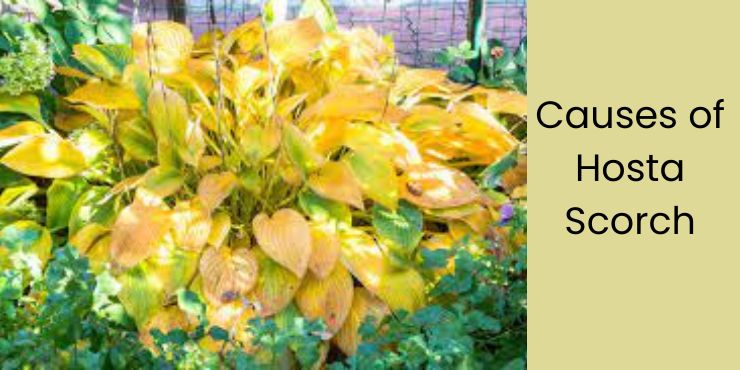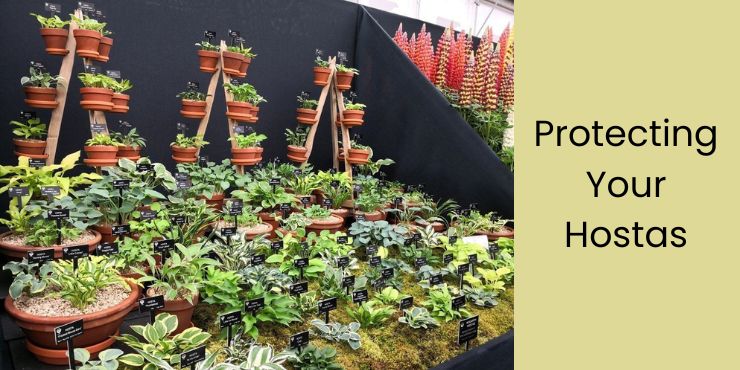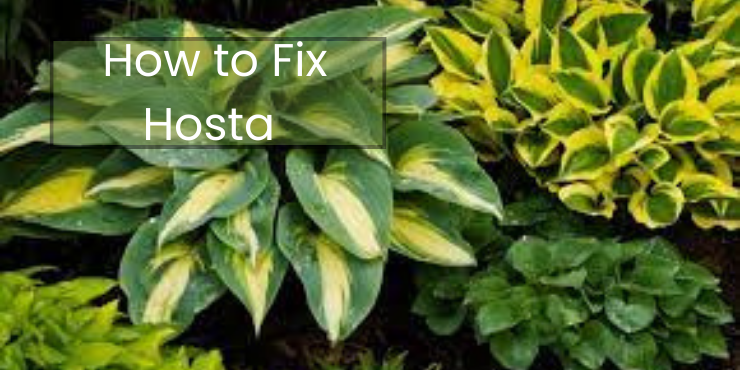Introduction
Fix Hosta scorch are beloved garden plants known for their lush foliage and vibrant colors. However, one common issue that can plague these beauties is hosta scorch. If you’ve noticed your hostas displaying brown or yellowed leaves, it’s essential to take action promptly. In this comprehensive guide, we’ll delve into the world of hosta scorch, discussing its causes, symptoms, and, most importantly, how to fix it and restore your hostas to their full glory.
Understanding Hosta Scorch
What is Hosta Scorch?
Hosta scorch, also known as Hosta virus X (HVX), is a viral disease that affects hosta plants, which are cherished for their stunning foliage and ornamental value. This plant ailment can be a significant concern for gardeners, as it can cause considerable damage to these beloved garden denizens.
The primary cause of hosta scorch is viral infection, typically spread through the exchange of infected plant material. This can occur when gardeners divide hosta plants or use contaminated gardening tools, unwittingly transmitting the virus from one plant to another. Additionally, aphids, tiny insects often found in gardens, can act as vectors for HVX, transmitting the virus when they feed on the sap of infected hostas and then move on to uninfected plants.
Identifying fix hosta scorch is vital for effective management. The symptoms of this viral disease are distinctive and include leaf discoloration, with infected leaves displaying irregular yellow or brown streaks. Growth can become distorted, leading to misshapen leaves and stunted overall plant development. The vibrant colors that make hostas so attractive can also fade due to the virus. Circular, ring-like patterns may develop on leaves, further indicating the presence of HVX.
Addressing Fix hosta scorch requires prompt action. Infected plants should be isolated to prevent the virus from spreading to healthy hostas. Additionally, the removal of affected leaves is essential to mitigate the disease’s impact. When pruning, it’s crucial to handle the infected material carefully to prevent further transmission.
To prevent hosta scorch, gardeners can take several preventive measures. Quarantining new hostas for a few weeks before introducing them to the garden allows time to detect any signs of infection. Regularly sanitizing gardening tools is also essential, as this can help prevent the inadvertent transmission of the virus from one plant to another.
In conclusion, hosta scorch is a viral disease that can pose a threat to the health and beauty of hosta plants. However, with proper identification, isolation, removal of infected material, and preventive measures, gardeners can protect their hostas from this potentially devastating ailment and continue to enjoy the splendor of these garden favorites.
Causes of Hosta Scorch

Hosta scorch, a viral disease that affects hosta plants, can wreak havoc in your garden if not properly managed. Understanding the causes of hosta scorch is crucial for preventing and addressing this troublesome ailment.
The primary culprit behind hosta scorch is a virus known as Hosta virus X (HVX). This virus is responsible for infecting and damaging hosta plants. HVX is typically transmitted through various means:
- Infected Plant Material: One of the most common ways HVX spreads is through infected plant material. When gardeners divide hosta plants for propagation or share them with others, there’s a risk of transferring the virus. It’s essential to inspect any hosta you acquire or share to ensure it’s free from infection.
- Contaminated Gardening Tools: HVX can also be transmitted through gardening tools. If you use pruners, scissors, or other equipment on infected hostas and then use the same tools on healthy plants, the virus can easily spread. Regularly cleaning and disinfecting your gardening tools is a simple yet effective way to prevent transmission.
- Aphid Vectors: Aphids, tiny insects commonly found in gardens, can act as vectors for HVX. These pests feed on plant sap and can inadvertently transmit the virus from infected hostas to healthy ones. Managing aphid populations in your garden is an essential part of hosta scorch prevention.
Recognizing the role of these transmission mechanisms is crucial for preventing hosta scorch from taking hold in your garden. By being vigilant about the health of your hosta plants, regularly inspecting them for signs of infection, and taking steps to prevent the spread of the virus, you can protect your beautiful hostas from this damaging disease.
Identifying Hosta Scorch
Symptoms
Hosta scorch, caused by the Hosta virus X (HVX), can silently afflict your cherished hosta plants, leading to unsightly damage if left unchecked. Recognizing the symptoms of hosta scorch is crucial for timely intervention and preserving the health and beauty of your garden.
The symptoms of hosta scorch are distinctive and can manifest in several ways:
- Leaf Discoloration: One of the most noticeable signs of hosta scorch is leaf discoloration. Infected leaves often develop irregular yellow or brown streaks. These streaks can be subtle at first but may become more pronounced as the infection progresses.
- Distorted Growth: Hosta scorch can significantly impact the growth of your hosta plants. Infected leaves may become misshapen, with unusual curves or crinkles. This distortion can make the plant look unhealthy and less aesthetically pleasing.
- Fading Colors: The vibrant colors that make hostas so appealing can fade in infected plants. Leaves may lose their lush green hues, becoming paler and less vibrant over time.
- Ring Spots: Circular or ring-like patterns may appear on the leaves of infected hostas. These spots can vary in size and color, adding to the overall visual deterioration of the plant.
Identifying these symptoms promptly is crucial because early intervention can help prevent further spread of the virus and minimize damage to your hosta plants. Regular inspection of your hostas, especially during the growing season, can help you spot these signs before they become severe.
If you notice any of these symptoms on your hosta plants, it’s essential to take action promptly. Isolate infected hostas to prevent the virus from spreading to healthy plants, and remove and dispose of the affected leaves to reduce the virus’s presence. By staying vigilant and addressing hosta scorch symptoms as soon as they appear, you can protect your garden’s beauty and keep your hostas thriving.
Treating Hosta Scorch
When hosta scorch, caused by the Hosta virus X (HVX), strikes your garden, swift and decisive action is essential to prevent the spread of this viral disease and salvage the health of your hosta plants. Two critical steps in treating hosta scorch are isolation and removal.
Isolation
The moment you suspect or confirm hosta scorch in your garden, it’s crucial to isolate the infected plants. Isolation serves two primary purposes:
- Preventing Spread: By isolating infected hostas, you minimize the risk of the virus spreading to healthy plants. HVX is highly contagious and can quickly infect neighboring hostas if precautions aren’t taken.
- Focus on Treatment: Isolation allows you to focus your treatment efforts on the affected plants. This targeted approach increases the chances of successfully managing the disease.
To effectively isolate infected hostas:
- Physically separate them from healthy plants. This can be achieved by moving them to a different part of the garden or placing a barrier between them and healthy hostas.
- Avoid using tools or equipment on infected hostas and then using them on healthy plants, as this can transmit the virus.
Removal
Once hosta scorch is confirmed, the next crucial step is the removal of affected plant material. Removing infected parts of the hosta serves several vital purposes:
- Reducing Virus Load: Removing infected leaves and sections of the plant reduces the overall viral load, which can slow the progression of the disease.
- Preventing Further Spread: Infected leaves and plant material are potential sources of viral transmission. Proper disposal ensures that the virus doesn’t linger in your garden.
To effectively remove infected material:
- Use sanitized pruning tools to carefully cut away infected leaves and stems. Dispose of the removed material away from your garden to prevent virus transmission.
- Pay attention to any new growth; if it shows signs of infection, promptly remove it.
By implementing strict isolation and removal protocols, you can contain hosta scorch and prevent it from devastating your entire hosta collection. Remember that early intervention is key to minimizing the impact of this viral disease and protecting the beauty of your garden.
Improve Plant Health
Hostas, with their lush foliage and vibrant colors, are garden favorites, but when plagued by hosta scorch, their beauty can diminish. Fortunately, there are steps you can take to improve the overall health of your hosta plants and address this viral disease effectively.
Proper Watering
Maintaining the right moisture levels is crucial for hosta health. Proper watering practices include:
- Consistent Moisture: Hostas prefer consistently moist soil. Ensure they receive enough water, especially during dry spells. Use mulch to help retain soil moisture.
- Avoid Overwatering: While hostas like moisture, they don’t tolerate waterlogged soil. Overwatering can stress the plants and make them more susceptible to diseases like hosta scorch. Ensure your soil drains well.
Fertilize Carefully
Fertilizing your hostas can provide essential nutrients for growth, but it’s vital to do so carefully:
- Balanced Fertilizer: Use a balanced, slow-release fertilizer formulated for ornamental plants. This will provide the necessary nutrients without promoting excessive growth that can attract pests.
- Follow Instructions: Read and follow the manufacturer’s instructions for fertilizer application to prevent overfertilization, which can harm your hostas.
Resistant Hosta Varieties
Consider planting hosta varieties known for their resistance to hosta scorch. While no hosta is completely immune, some cultivars show greater resilience to the virus. Research and select hostas with a history of resistance in your region.
Pruning and Maintenance
Regularly inspect your hosta plants for signs of infection, such as discolored or distorted leaves. If you notice any symptoms, promptly prune and remove the affected parts to reduce the virus’s presence.
Pest Control
Keep an eye out for aphids and other potential vectors of hosta scorch. Implement pest control measures to minimize their presence in your garden. This can include using insecticidal soaps or natural predators to manage aphid populations.
By following these guidelines and adopting a proactive approach to hosta care, you can significantly improve the health of your hosta plants and reduce their vulnerability to hosta scorch. Remember that a healthy plant is better equipped to resist and recover from diseases, making your garden a vibrant and thriving space.
Prevention
Protecting Your Hostas

Preventing hosta scorch, caused by the Hosta virus X (HVX), is the most effective way to ensure the health and vitality of your beloved hosta plants. By implementing a few simple yet essential preventive measures, you can safeguard your garden’s hosta collection.
Quarantine New Additions
When introducing new hosta plants to your garden, it’s crucial to exercise caution:
- Isolate New Hostas: Keep newly acquired hostas isolated from your existing collection for a few weeks. This quarantine period allows you to monitor them for any signs of infection before they come into close contact with healthy hostas.
Sanitize Garden Tools
Regularly cleaning and disinfecting your gardening tools is an often-overlooked but vital aspect of hosta scorch prevention:
- Tool Maintenance: Clean and disinfect all gardening tools, including pruners and scissors, after each use. HVX can be easily transmitted through contaminated tools, so this practice helps prevent accidental spread.
- Proper Handling: When working with hostas, avoid using the same tools on infected and healthy plants without proper cleaning in between.
Aphid Control
Aphids are notorious vectors of HVX, making pest control an integral part of hosta scorch prevention:
- Monitor Aphid Populations: Regularly inspect your hostas for aphids and take action if you notice an infestation.
- Use Aphid Control Measures: Employ appropriate aphid control methods, such as using insecticidal soaps or introducing natural predators, to manage aphid populations in your garden.
Responsible Plant Care
Maintain good plant care practices to ensure the overall health of your hostas:
- Proper Watering: Avoid overwatering, as waterlogged soil can stress hostas. Instead, aim for consistent moisture levels by watering as needed.
- Fertilize Wisely: Use balanced, slow-release fertilizers designed for ornamental plants to provide necessary nutrients without overstimulating growth.
By following these prevention strategies and integrating them into your gardening routine, you can create a protective shield around your hostas, reducing the risk of hosta scorch. Vigilance and responsible plant care are your allies in maintaining the beauty and health of your garden’s hosta plants.
Conclusion
Hosta scorch can be a daunting challenge for gardeners, but with the right knowledge and actions, you can save your beloved hostas. Remember to isolate and remove infected plants, improve overall plant health, and consider planting resistant hosta varieties. By following these steps and practicing proper prevention measures, you can keep your garden hosta scorch-free and thriving.
FAQs
1. Can hosta scorch spread to other plants in my garden?
Yes, hosta scorch can infect other hosta plants and certain related species, so it’s crucial to take preventive measures.
2. Are there any natural remedies for hosta scorch?
While there is no cure for hosta scorch, maintaining good plant health and using resistant cultivars are the best strategies for prevention.
3. Can I save an infected hosta plant?
In some cases, if the infection is not severe, you may be able to save an infected hosta by following strict isolation and removal protocols.
4. How do I know if a hosta variety is resistant to HVX?
Check with your local nursery or do some research online to find hosta varieties known for their resistance to hosta scorch.
5. Is hosta scorch harmful to humans or pets?
No, hosta scorch is specific to hosta plants and does not pose a threat to humans or pets.


